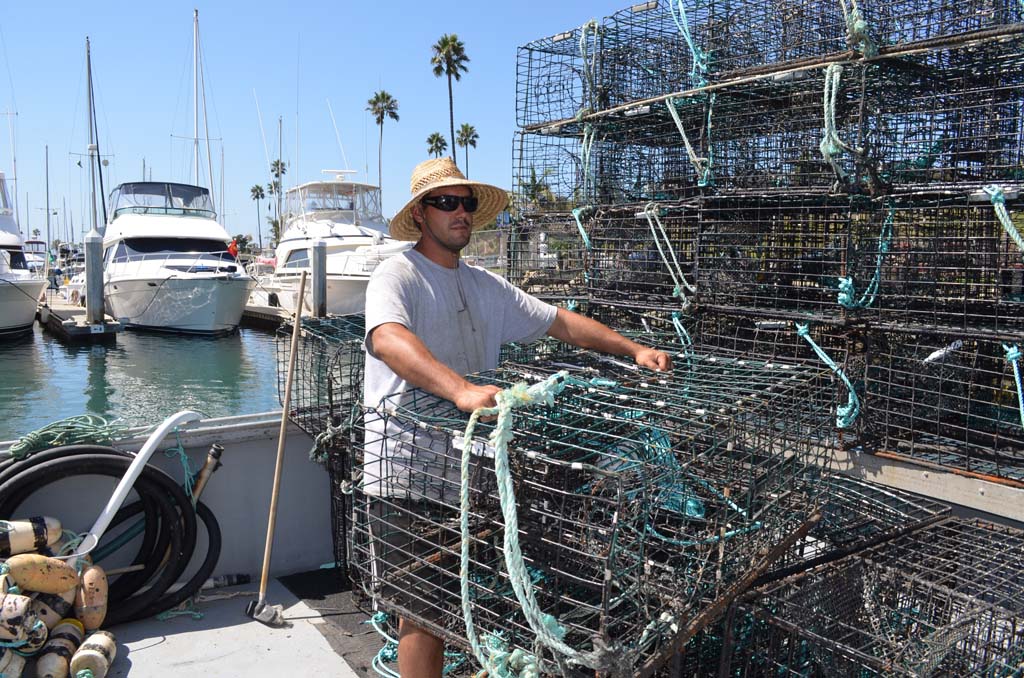COAST CITIES — Poaching. Lobster traps where they shouldn’t be. Spearfishing protected species.
These are the kinds of violations Cyndy Pourroy, a warden with the California Department of Fish and Wildlife, was on the lookout for as she gazed out over Swami’s marine protected area from a staircase near Tide Park beach.
“Everything looks normal,” Pourroy said, without having to look through the binoculars she held in her hand. Her stakeouts typically take place in spots that are more clandestine, and often at night. Regardless of where or when, Pourroy said most have respected the marine protected areas that went into effect a year ago.
The new marine areas, aimed at replenishing marine life along the coastline, doubled the size of reserves. Within them, fishing is banned or limited.
Fishermen, who had fought the marine protected areas tooth and nail, have largely complied with the marine protected areas, according to state Fish and Wildlife officials. But one year in, fishermen say poaching is a growing issue because there has not been an increase in wardens to patrol the expanded reserves.
Pourroy has cited a few people for breaking the rules in the new marine protected areas. The first anniversary has passed with other violations, too.
According to preliminary Fish and Game data, six misdemeanor tickets were issued in San Diego County for illegally fishing in marine protected areas. Typically, misdemeanors carry up to a $1,000 fine, with the possibility of up to six months in jail, though none of the cases in San Diego went to court. Less severe tickets have also been handed out, but data wasn’t available for those.
As a comparison, there were 40 misdemeanor tickets in Orange County. The most notable case? A man caught poaching 47 lobsters. And as a result he served a seven-day jail sentence and was fined $20,000.
“I haven’t seen a violation on that scale,” Pourroy said while scanning the Batiquitos Lagoon, a marine protected area.
She motioned toward the eastern part of the lagoon, noting where she had issued an infraction — the equivalent of a traffic ticket — to a fisherman who had blatantly angled in the area, which is a no-take zone. The penalty was an exception. This year has mainly seen education and warnings.
Fish and Wildlife wanted to give fishermen, particularly novices, plenty of time to become acquainted with the new marine protected areas.
“Education will always be our most important deterrent; we’re very good at outreach,” Pourroy said.
As well as the wardens’ educational efforts, Pourroy noted Fish and Wildlife has a website and smart phone app that spells out the boundaries of the marine protected areas, and what exactly is allowed in them. It’s a useful tool because many don’t realize, for instance, that as a result of the new regulations, the Swami’s marine area added nearly three miles of protection, Pourroy said.
Pourroy noted wardens use observation tactics and tips from a hotline to locate hotspots for poaching. Stopping poachers, however, isn’t always easy.
This summer while on the shore, Pourroy spotted four people illegally fishing off a boat in the Swami’s marine protected area. She had access to small Fish and Wildlife boats, but the vessels aren’t powerful enough to make it out past the surf, she explained. Pourroy could have called another marine agency to track down the violators. Yet there wasn’t enough time. The boat got away.
Fish and Wildlife has an enforcement boat based out of Orange County that’s more than capable of chasing down poachers. It also patrols San Diego’s waters, but Pourroy said it’s not enough.
“We need a dedicated boat or two like that in San Diego County,” Pourroy said.
Scott Bringman, a patrol lieutenant with Fish and Wildlife, agreed that additional enforcement boats would help catch poachers or anyone else breaking the rules.
However, there isn’t funding for boats. Nor is there money for additional wardens. The number of wardens in Southern California has hovered around 70 for the past five years, even though there’s more marine protected areas to patrol.
Still, Bringman said wardens have been effective with what resources they have, especially given that other law enforcement agencies work in conjunction with them.
“People have been compliant; we haven’t had major issues,” Bringman said.
“A year is too soon to judge the areas,” Bringman added. “I think we’ll know more about the effects on marine life, and how to handle any problems with enforcement later.”
Shad Catarius, a San Diego commercial lobsterman, said the marine protected areas have hurt his catch. Although he doesn’t like them, Catarius said he and other fishermen have abided by the regulations.
Because there isn’t additional staff to patrol the new marine protected areas, he said poaching is becoming more of an issue across Southern California.
“Poaching has always been a problem,” Catarius said. “Now it’s worse — the wardens are spread thin.”
“I would say it’s been twice as bad as previous years,” he added.
With no extra personnel or resources for the expanded marine protected areas, a variety of nonprofits have stepped up their involvement.
On the education front, Surfrider has installed basic signs across the state denoting the boundaries of the marine protected areas. In the next year or two, Surfrider will replace the signs with permanent plaques that display images, maps and histories of the reserves, noted Stefanie Sekich-Quinn, policy manager for Surfrider.
Additionally, Surfrider has held public forums and set up tables at places like Swami’s to educate the public about the new reserves.
“We went through this lengthy process to implement the marine protected areas,” Quinn said. “Our feeling is that we should educate people and continue to protect them.”
San Diego Coastkeeper partnered with engineering students at UC San Diego to monitor reserves in La Jolla. Armed with a smartphone app developed by the students, trained volunteers track how many people are swimming, surfing or fishing in the marine protected areas on a weekly basis. The information is then logged in a database.
Megan Baehrens, executive director of San Diego Coastkeeper, said that the information would inform policymakers when they review the new marine protected areas in five years.
“They’ll have a better idea of just who is using the reserves,” Baehrens said. “The information could help them with better enforcement, or maybe with changing the rules in them based on trends.”
“We’re at the post-implementation phase of the marine areas; our work here is not done,” Baehrens said.



